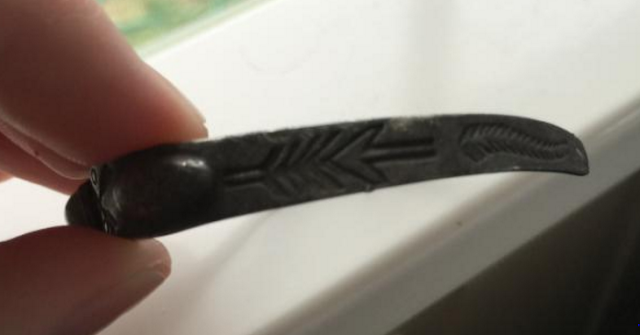Written by the TreasureGuide for the exclusive use of treasurebeachesreport.blogspot.com.
 |
| New Fort Pierce Land Find |
I just received the following email about a very interesting Fort Pierce area find (shown above).
... My husband and I live in an older home on S Indian River Dr about a mile south of town. My husband and a friend cut down an old tree in our yard and when they were digging out the stump, they found this bracelet about 2 to 3 feet underground. Do you have any idea what this may be from? It looks like there are little arrows carved into it... so possibly Native American? I'm not sure what the stone is. The color of this stone is like a sage green. I think the metal is silver and there is a mark on it where the shovel hit it.
On a side note, I have followed your blog for years, and contacted you a few years ago about another object we found on Pompano Beach. We used to live in Fort Lauderdale and have been metal detecting on and off for years. We actually found this without the detector though! Haha.
Hope you can provide some insight into where this may have come from. Thanks for your help!
Thanks for the email and pictures. My guess, going just from the photos, is that it might be silver and turquoise. Silver and turquoise Native American jewelry was popular back in the 70s, but if the item was from that time period I'd expect it to be marked. If no marks are found, it should be tested to determine if it is silver.
Many trade beads and other Seminole artifacts have been found on home sites south of Ft. Pierce along the drive south of Fort Pierce, so it was found in an area where Seminole artifacts are commonly found.
Being under two or three feet of earth could support the idea that it is older.
What do you all think? Let me know.
There are a lot of things under the ground, and some of them are too deep to be detected by most metal detectors. The tree would have been an obstacle too.
The type of tree could be relevant. Was it gumbo limbo? Those trees are often associated with Indian sites.
Of course there are other possibilities. In some areas up north an iron item was often buried when a new tree was planted. It was thought that the iron was good for the tree.
I hope to have a detailed post about how much is actually in the ground. The site was thoroughly sifted and investigated.
---
What do you all think? Let me know.
There are a lot of things under the ground, and some of them are too deep to be detected by most metal detectors. The tree would have been an obstacle too.
The type of tree could be relevant. Was it gumbo limbo? Those trees are often associated with Indian sites.
Of course there are other possibilities. In some areas up north an iron item was often buried when a new tree was planted. It was thought that the iron was good for the tree.
I hope to have a detailed post about how much is actually in the ground. The site was thoroughly sifted and investigated.
---
What do you get by crossing a donkey and a horse? Would it be a dorse, or maybe a horkey? Neither, of course. Most commonly it would be a mule if it came from a male donkey and a female horse, or a hinny if it came from a female donkey and a male horse.
Here is an interesting history about the roll of mules in the U.S. military.
http://www.transportation.army.mil/historian/documents/pack%20mules.pdf
And here is an excerpt.
Just thought that was interesting.
Happy hunting,
TreasureGuide@comcast.net
Here is an interesting history about the roll of mules in the U.S. military.
http://www.transportation.army.mil/historian/documents/pack%20mules.pdf
And here is an excerpt.
The size of a mule and work to which it is put depend largely on the breeding of the mule's dam (female parent). Mules can be lightweight, medium weight, or even, when produced from draft horse mares, of moderately heavy weight.[2]:85–87
Mules are "more patient, sure-footed, hardy and long-lived than horses, and they are considered less obstinate, faster, and more intelligent than donkeys."[3]:5
The mule is a hybrid of a horse and donkey. Collectively four or six mules could carry
more in a wagon than they could individually on their backs with the current pack system. The
average wagon load was a ton to a ton and a half as compared to only two hundred to two
hundred and fifty pounds on a pack. The key issue was that individually they could keep up with
the cavalry column while the wagons could not. Crook would find the solution.
Crook had some experience working with pack mules fighting Indians prior to the Civil
War. Pack mules were a common sight around the mining areas along the Pacific Coast. When
promoted to the Commander of the Department of Arizona in 1871, Crook finally had the
resources to work on the problem. He had his quartermaster purchase 15,000 mules and
recruited civilian packers. Crook hired Thomas Moore as his chief packer and Dave Mears as
his assistant to recruit, train, equip, organize and supervise the pack trains. Crook then treated
the study of the pack trains as a science. He learned that if they custom fitted the aparejo pack to
each mule, they could increase the weight carried to four hundred pounds. Loading only mission
essential items such as food, ammunition and medical supplies made field operations leaner.
With the load capacity of each mule increased, Crook then set out to plan the organization of the
train.
Just thought that was interesting.
Happy hunting,
TreasureGuide@comcast.net
